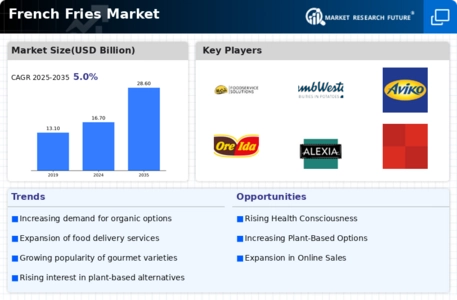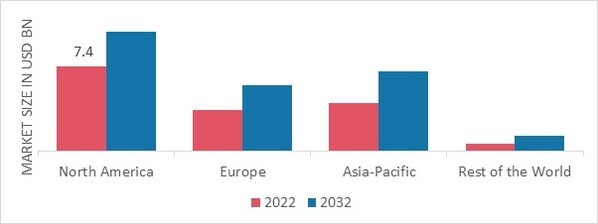-
EXECUTIVE SUMMARY
-
MARKET INTRODUCTION
-
Definition
-
Scope of the Study
- Research Objective
- Assumptions
- Limitations
-
RESEARCH METHODOLOGY
-
Overview
-
Data Mining
-
Secondary Research
-
Primary Research
- Primary Interviews and Information Gathering Process
- Breakdown of Primary Respondents
-
Forecasting Model
-
Market Size Estimation
- Bottom-Up Approach
- Top-Down Approach
-
Data Triangulation
-
Validation
-
MARKET DYNAMICS
-
Overview
-
Drivers
-
Restraints
-
Opportunities
-
MARKET FACTOR ANALYSIS
-
Value Chain Analysis
-
Porter’s Five Forces Analysis
- Bargaining Power of Suppliers
- Bargaining Power of Buyers
- Threat of New Entrants
- Threat of Substitutes
- Intensity of Rivalry
-
COVID-19 Impact Analysis
- Market Impact Analysis
- Regional Impact
- Opportunity and Threat Analysis
-
GLOBAL FRENCH FRIES MARKET, BY PRODUCT
-
Overview
-
Fresh
-
Frozen
-
GLOBAL FRENCH FRIES MARKET, BY END-USE
-
Overview
-
Food Service
-
Retail
-
GLOBAL FRENCH FRIES MARKET, BY REGION
-
Overview
-
North America
- U.S.
- Canada
-
Europe
- Germany
- France
- U.K
- Italy
- Spain
- Rest of Europe
-
Asia-Pacific
- China
- India
- Japan
- South Korea
- Australia
- Rest of Asia-Pacific
-
Rest of the World
- Middle East
- Africa
- Latin America
-
COMPETITIVE LANDSCAPE
-
Overview
-
Competitive Analysis
-
Market Share Analysis
-
Major Growth Strategy in the Global French Fries Market,
-
Competitive Benchmarking
-
Leading Players in Terms of Number of Developments in the Global French Fries Market,
-
Key developments and Growth Strategies
- New PRODUCT Launch/End-Use Deployment
- Merger & Acquisitions
- Joint Ventures
-
Major Players Financial Matrix
- Sales & Operating Income, 2022
- Major Players R&D Expenditure. 2022
-
COMPANY PROFILES
-
McCain Foods Limited (Canada)
- Company Overview
- Financial Overview
- Product Offered
- Key Developments
- SWOT Analysis
- Key Strategies
-
J.R. Simplot Company (U.S.)
- Company Overview
- Financial Overview
- Product Offered
- Key Developments
- SWOT Analysis
- Key Strategies
-
Lamb Weston (U.S.)
- Company Overview
- Financial Overview
- Product Offered
- Key Developments
- SWOT Analysis
- Key Strategies
-
Farm Frites International B.V. (Netherlands)
- Company Overview
- Financial Overview
- Product Offered
- Key Developments
- SWOT Analysis
- Key Strategies
-
Aviko (Netherlands)
- Company Overview
- Financial Overview
- Product Offered
- Key Developments
- SWOT Analysis
- Key Strategies
-
Ore-Ida (U.S.)
- Company Overview
- Financial Overview
- Product Offered
- Key Developments
- SWOT Analysis
- Key Strategies
-
Cascadian Farm Organics (U.S.)
- Company Overview
- Financial Overview
- Product Offered
- Key Developments
- SWOT Analysis
- Key Strategies
-
Alexia Foods (U.S.)
- Company Overview
- Financial Overview
- Product Offered
- Key Developments
- SWOT Analysis
- Key Strategies
-
Checkers Rally’s (U.S.)
- Company Overview
- Financial Overview
- Product Offered
- Key Developments
- SWOT Analysis
- Key Strategies
-
Arby’s IP Holder (U.S.)
- Company Overview
- Financial Overview
- Product Offered
- Key Developments
- SWOT Analysis
- Key Strategies
-
APPENDIX
-
References
-
Related Reports
-
-
LIST OF TABLES
-
GLOBAL FRENCH FRIES MARKET, SYNOPSIS, 2018-2032
-
GLOBAL FRENCH FRIES MARKET, ESTIMATES & FORECAST, 2018-2032 (USD BILLION)
-
GLOBAL FRENCH FRIES MARKET, BY PRODUCT, 2018-2032 (USD BILLION)
-
GLOBAL FRENCH FRIES MARKET, BY END-USE, 2018-2032 (USD BILLION)
-
NORTH AMERICA FRENCH FRIES MARKET, BY PRODUCT, 2018-2032 (USD BILLION)
-
NORTH AMERICA FRENCH FRIES MARKET, BY END-USE, 2018-2032 (USD BILLION)
-
NORTH AMERICA FRENCH FRIES MARKET, BY COUNTRY, 2018-2032 (USD BILLION)
-
U.S. FRENCH FRIES MARKET, BY PRODUCT, 2018-2032 (USD BILLION)
-
U.S. FRENCH FRIES MARKET, BY END-USE, 2018-2032 (USD BILLION)
-
CANADA FRENCH FRIES MARKET, BY PRODUCT, 2018-2032 (USD BILLION)
-
CANADA FRENCH FRIES MARKET, BY END-USE, 2018-2032 (USD BILLION)
-
EUROPE FRENCH FRIES MARKET, BY PRODUCT, 2018-2032 (USD BILLION)
-
EUROPE FRENCH FRIES MARKET, BY END-USE, 2018-2032 (USD BILLION)
-
EUROPE FRENCH FRIES MARKET, BY COUNTRY, 2018-2032 (USD BILLION)
-
GERMANY FRENCH FRIES MARKET, BY PRODUCT, 2018-2032 (USD BILLION)
-
GERMANY FRENCH FRIES MARKET, BY END-USE, 2018-2032 (USD BILLION)
-
FRANCE FRENCH FRIES MARKET, BY PRODUCT, 2018-2032 (USD BILLION)
-
FRANCE FRENCH FRIES MARKET, BY END-USE, 2018-2032 (USD BILLION)
-
ITALY FRENCH FRIES MARKET, BY PRODUCT, 2018-2032 (USD BILLION)
-
ITALY FRENCH FRIES MARKET, BY END-USE, 2018-2032 (USD BILLION)
-
SPAIN FRENCH FRIES MARKET, BY PRODUCT, 2018-2032 (USD BILLION)
-
SPAIN FRENCH FRIES MARKET, BY END-USE, 2018-2032 (USD BILLION)
-
U.K FRENCH FRIES MARKET, BY PRODUCT, 2018-2032 (USD BILLION)
-
U.K FRENCH FRIES MARKET, BY END-USE, 2018-2032 (USD BILLION)
-
REST OF EUROPE FRENCH FRIES MARKET, BY PRODUCT, 2018-2032 (USD BILLION)
-
REST OF EUROPE FRENCH FRIES MARKET, BY END-USE, 2018-2032 (USD BILLION)
-
ASIA PACIFIC FRENCH FRIES MARKET, BY PRODUCT, 2018-2032 (USD BILLION)
-
ASIA PACIFIC FRENCH FRIES MARKET, BY END-USE, 2018-2032 (USD BILLION)
-
ASIA PACIFIC FRENCH FRIES MARKET, BY COUNTRY, 2018-2032 (USD BILLION)
-
JAPAN FRENCH FRIES MARKET, BY PRODUCT, 2018-2032 (USD BILLION)
-
JAPAN FRENCH FRIES MARKET, BY END-USE, 2018-2032 (USD BILLION)
-
CHINA FRENCH FRIES MARKET, BY PRODUCT, 2018-2032 (USD BILLION)
-
CHINA FRENCH FRIES MARKET, BY END-USE, 2018-2032 (USD BILLION)
-
INDIA FRENCH FRIES MARKET, BY PRODUCT, 2018-2032 (USD BILLION)
-
INDIA FRENCH FRIES MARKET, BY END-USE, 2018-2032 (USD BILLION)
-
AUSTRALIA FRENCH FRIES MARKET, BY PRODUCT, 2018-2032 (USD BILLION)
-
AUSTRALIA FRENCH FRIES MARKET, BY END-USE, 2018-2032 (USD BILLION)
-
SOUTH KOREA FRENCH FRIES MARKET, BY PRODUCT, 2018-2032 (USD BILLION)
-
SOUTH KOREA FRENCH FRIES MARKET, BY END-USE, 2018-2032 (USD BILLION)
-
REST OF ASIA-PACIFIC FRENCH FRIES MARKET, BY PRODUCT, 2018-2032 (USD BILLION)
-
REST OF ASIA-PACIFIC FRENCH FRIES MARKET, BY END-USE, 2018-2032 (USD BILLION)
-
REST OF WORLD FRENCH FRIES MARKET, BY PRODUCT, 2018-2032 (USD BILLION)
-
REST OF WORLD FRENCH FRIES MARKET, BY END-USE, 2018-2032 (USD BILLION)
-
REST OF WORLD FRENCH FRIES MARKET, BY COUNTRY, 2018-2032 (USD BILLION)
-
MIDDLE EAST FRENCH FRIES MARKET, BY PRODUCT, 2018-2032 (USD BILLION)
-
MIDDLE EAST FRENCH FRIES MARKET, BY END-USE, 2018-2032 (USD BILLION)
-
AFRICA FRENCH FRIES MARKET, BY PRODUCT, 2018-2032 (USD BILLION)
-
AFRICA FRENCH FRIES MARKET, BY END-USE, 2018-2032 (USD BILLION)
-
LATIN AMERICA FRENCH FRIES MARKET, BY PRODUCT, 2018-2032 (USD BILLION)
-
LATIN AMERICA FRENCH FRIES MARKET, BY END-USE, 2018-2032 (USD BILLION)
-
-
LIST OF FIGURES
-
RESEARCH PROCESS
-
MARKET STRUCTURE FOR THE GLOBAL FRENCH FRIES MARKET
-
MARKET DYNAMICS FOR THE GLOBAL FRENCH FRIES MARKET
-
GLOBAL FRENCH FRIES MARKET, SHARE (%), BY PRODUCT, 2022
-
GLOBAL FRENCH FRIES MARKET, SHARE (%), BY END-USE, 2022
-
GLOBAL FRENCH FRIES MARKET, SHARE (%), BY REGION, 2022
-
NORTH AMERICA: FRENCH FRIES MARKET, SHARE (%), BY REGION, 2022
-
EUROPE: FRENCH FRIES MARKET, SHARE (%), BY REGION, 2022
-
ASIA-PACIFIC: FRENCH FRIES MARKET, SHARE (%), BY REGION, 2022
-
REST OF THE WORLD: FRENCH FRIES MARKET, SHARE (%), BY REGION, 2022
-
GLOBAL FRENCH FRIES MARKET: COMPANY SHARE ANALYSIS, 2022 (%)
-
MCCAIN FOODS LIMITED (CANADA): FINANCIAL OVERVIEW SNAPSHOT
-
MCCAIN FOODS LIMITED (CANADA): SWOT ANALYSIS
-
J.R. SIMPLOT COMPANY (U.S.): FINANCIAL OVERVIEW SNAPSHOT
-
J.R. SIMPLOT COMPANY (U.S.): SWOT ANALYSIS
-
LAMB WESTON (U.S.): FINANCIAL OVERVIEW SNAPSHOT
-
LAMB WESTON (U.S.): SWOT ANALYSIS
-
FARM FRITES INTERNATIONAL B.V. (NETHERLANDS): FINANCIAL OVERVIEW SNAPSHOT
-
FARM FRITES INTERNATIONAL B.V. (NETHERLANDS): SWOT ANALYSIS
-
AVIKO (NETHERLANDS).: FINANCIAL OVERVIEW SNAPSHOT
-
AVIKO (NETHERLANDS).: SWOT ANALYSIS
-
ORE-IDA (U.S.): FINANCIAL OVERVIEW SNAPSHOT
-
ORE-IDA (U.S.): SWOT ANALYSIS
-
CASCADIAN FARM ORGANICS (U.S.): FINANCIAL OVERVIEW SNAPSHOT
-
CASCADIAN FARM ORGANICS (U.S.): SWOT ANALYSIS
-
ALEXIA FOODS (U.S.): FINANCIAL OVERVIEW SNAPSHOT
-
ALEXIA FOODS (U.S.): SWOT ANALYSIS
-
CHECKERS RALLY’S (U.S.): FINANCIAL OVERVIEW SNAPSHOT
-
CHECKERS RALLY’S (U.S.): SWOT ANALYSIS
-
ARBY’S IP HOLDER (U.S.): FINANCIAL OVERVIEW SNAPSHOT
-
ARBY’S IP HOLDER (U.S.): SWOT ANALYSIS'










Leave a Comment